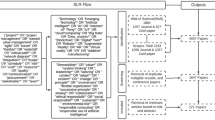Abstract
Software Development Community is moving towards adopting cloud due to the innumerous benefits of this computing paradigm. Cloud applications are architecturally required to be service oriented and therefore the software development process for developing cloud applications possess certain attributes to fully realize the potential of this computing and be aligned with the service dominant perspective. The purpose of this study is to identify, analyze and investigate the attributes of software development process for cloud application development to formulate a relational model. We used interpretive structural modeling approach to establish contextual relationship amongst the identified attributes and proposed a hierarchical structural model. The attributes are classified on the basis of their driving and dependence power through Impact Matrix Cross reference Multiplication applied to Classification. From the results, we observe that imbibing lean software development principles and model driven development emerge as strong driving attributes for cloud application development process.




Similar content being viewed by others
References
Attri R, Grover S, Dev N, Kumar D (2013a) An ISM approach for modelling the enablers in the implementation of total productive maintenance. Int J Syst Assur Eng Manag 4(4):313–326
Attri R, Grover S, Dev N, Kumar D (2013b) Analysis of barriers of total productive maintenance (TPM). Int J Syst Assur Eng Manag 4(4):365–377
Buyya R, Yeo CS, Venugopal S, Broberg J, Brandic I (2009) Cloud computing and emerging IT platforms: vision, hype, and reality for delivering computing as the 5th utility. Future Gener Comput Syst 25(6):599–616. doi:10.1016/j.future.2008.12.001
Das D, Vaidya K (2011) An agile process framework for cloud application development. Computer Science Corporation, Falls Church
Georgakopoulos A (2006) Teacher effectiveness examined as a system: interpretive structural modeling and facilitation sessions with US and Japanese students. Int Educ Stud 2(3):60–76
Grundy J, Kaefer G, Jacky K, Liu A (2012) Software engineering for the cloud. IEEE Softw 29(2):26–29
Guha R, and Al-Dabass D (2010) Impact of web 2.0 and Cloud computing platform on software engineering. In: 2010 International Symposium on Electronic System Design. doi: 10.1109/ISED.2010.48
Hasteer N, Bansal A, Murthy BK (2016) Software process paradigms and crowdsourced software development: an overview. In: Graham C (ed) Strategic management and leadership for systems development in virtual spaces. IGI Global, Hershey, pp 229–246. doi:10.4018/978-1-4666-9688-4
Howe, J. (2006). The rise of crowdsourcing. Wired magazine. http://www.wired.com/wired/archive/14.06/crowds_pr.html
Huang J-J, Tzeng G-H, Ong C-S (2005) Multidimensional data in multidimensional scaling using the analytic network process. Pattern Recogn Lett 26(6):755–767. doi:10.1016/j.patrec.2004.09.027
Kazman R, Chen H (2009) The metropolis model a new logic for development of crowdsourced systems. Commun ACM 52(7):76–84
Kazman R, and Chen H-M (2010) The metropolis model and its implications for the engineering of software ecosystems. In: Proceedings of the FSE/SDP Workshop on Future of Software Engineering Research—FoSER’10, 187. doi: 10.1145/1882362.1882402
KPMG (2011) Impact of the cloud on the IT ecosystem. In: The cloud—changing the business ecosystem. KPMG, India, pp 13–16
Lakhani KR, Garvin DA, Lonstein E (2010) TopCoder (A): developing software through crowdsourcing. Harvard business school general management unit case no. 610-032, pp 1–19
Majumdar R, Kapur PK, Khatri SK (2016) Assessment of environmental factors affecting software development process using ISM & MICMAC analysis. Int J Syst Assur Eng Manag. doi:10.1007/s13198-016-0477-4
Mao K, Capra L, Harman M, Jia Y (2015) A survey of the use of crowdsourcing in software engineering (pp 1–36). UCL Research Note RN/15/01. London
Mell P, Grance T (2011) The NIST definition of cloud computing. NIST Special Publication, 800-145. National Institute of Standards and Technology (NIST), Gaithersburg, MD
Ravi V, Shankar R (2005) Analysis of interactions among the barriers of reverse logistics. Technol Forecast Soc Change 72(April):1011–1029
Salesforce (2008) Agile development meets cloud computing for extraordinary results at salesforce.com, San Francisco. http://www.developerforce.com/media/ForcedotcomBookLibrary/WP_Agile_112608.pdf
TopCoder (2001) https://www.topcoder.com
Tsai W-T, Wu W, Huhns MN (2014) Cloud-based software crowdsourcing. Internet Comput 18(3):78–83
Warfield JN (1974a) Developing interconnection matrices in structural modeling. IEEE Trans Syst Man Cybern 4(1):81–87
Warfield JN (1974b) Toward interpretation of complex structural models. IEEE Trans Syst Man Cybern 4(5):405–417
Wu W, Tsai W, Li W (2013) Creative software crowdsourcing: from components and algorithm development to project concept formations. Int J Creat Comput 1(1):57–91
Yu J, Cooper H (1983) A quantitative review of research design effects on response rates to questionnaires. J Market Res 20:36–44
Author information
Authors and Affiliations
Corresponding author
Rights and permissions
About this article
Cite this article
Hasteer, N., Bansal, A. & Murthy, B.K. Assessment of cloud application development attributes through interpretive structural modeling. Int J Syst Assur Eng Manag 8 (Suppl 2), 1069–1078 (2017). https://doi.org/10.1007/s13198-017-0571-2
Received:
Revised:
Published:
Issue Date:
DOI: https://doi.org/10.1007/s13198-017-0571-2




